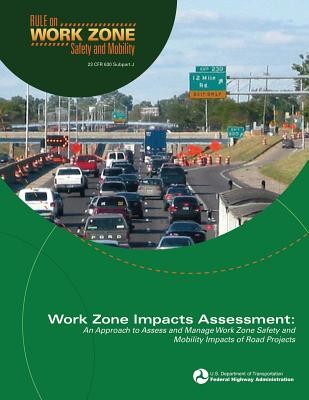
- We will send in 10–14 business days.
- Author: Federal Highway Administration
- Publisher: CreateSpace Independent Publishing Platform
- Year: 2015
- Pages: 180
- ISBN-10: 150859421X
- ISBN-13: 9781508594215
- Format: 21.6 x 28 x 1 cm, softcover
- Language: English
- SAVE -10% with code: EXTRA
Reviews
Description
This Guide is designed to help transportation agencies develop and/or update their own procedures for assessing and managing the work zone impacts of their road projects throughout the different program delivery stages. Understanding work zone impacts is critical to developing effective work zone transportation management plans (TMPs) that provide for safety, mobility, and quality in maintaining, rehabilitating, and rebuilding the nation's highways. The primary intended audience for this Guide is transportation agency staff, including technical staff (planners, designers, construction/traffic engineers, highway/safety engineers, etc.); management and executive-level staff responsible for setting policy and program direction; field staff responsible for building projects and managing work zones; and staff responsible for assessing performance in these areas. This document also provides support to agencies in their efforts to implement the recently updated work zone regulations. In September 2004, the FHWA published updates to the work zone regulations at 23 CFR 630 Subpart J. The updated rule is referred to as the Work Zone Safety and Mobility Rule (Rule) and applies to all State and local governments that receive Federal-aid highway funding. Transportation agencies are required to comply with the provisions of the Rule by October 12, 2007. The changes made to the regulations broaden the former Rule to better address the work zone issues of today and the future. The Rule provides a decision-making framework that facilitates comprehensive consideration of the broader safety and mobility impacts of work zones across project development stages, and the adoption of additional strategies that help manage these impacts during project implementation. The Rule requires agencies to develop an agency-level work zone safety and mobility policy to support systematic consideration and management of work zone impacts across all stages of project development. Based on the policy, agencies will develop processes and procedures to support implementation of the policy. These include procedures that address work zone impacts assessment, work zone data, work zone training, and process reviews. The Rule also calls for the development of project-level procedures to help agencies assess and manage the work zone impacts of individual projects. While the Rule does not require a specific work zone impacts assessment process/procedure, it recommends that agencies develop and implement systematic procedures to assess work zone impacts in project development, and to manage safety and mobility during project implementation. This document is the last of four guidance documents developed on the Rule, and provides a general approach for conducting work zone impacts assessment and management, as well as many examples of the approaches currently being used by transportation agencies.
EXTRA 10 % discount with code: EXTRA
The promotion ends in 19d.16:18:07
The discount code is valid when purchasing from 10 €. Discounts do not stack.
- Author: Federal Highway Administration
- Publisher: CreateSpace Independent Publishing Platform
- Year: 2015
- Pages: 180
- ISBN-10: 150859421X
- ISBN-13: 9781508594215
- Format: 21.6 x 28 x 1 cm, softcover
- Language: English English
This Guide is designed to help transportation agencies develop and/or update their own procedures for assessing and managing the work zone impacts of their road projects throughout the different program delivery stages. Understanding work zone impacts is critical to developing effective work zone transportation management plans (TMPs) that provide for safety, mobility, and quality in maintaining, rehabilitating, and rebuilding the nation's highways. The primary intended audience for this Guide is transportation agency staff, including technical staff (planners, designers, construction/traffic engineers, highway/safety engineers, etc.); management and executive-level staff responsible for setting policy and program direction; field staff responsible for building projects and managing work zones; and staff responsible for assessing performance in these areas. This document also provides support to agencies in their efforts to implement the recently updated work zone regulations. In September 2004, the FHWA published updates to the work zone regulations at 23 CFR 630 Subpart J. The updated rule is referred to as the Work Zone Safety and Mobility Rule (Rule) and applies to all State and local governments that receive Federal-aid highway funding. Transportation agencies are required to comply with the provisions of the Rule by October 12, 2007. The changes made to the regulations broaden the former Rule to better address the work zone issues of today and the future. The Rule provides a decision-making framework that facilitates comprehensive consideration of the broader safety and mobility impacts of work zones across project development stages, and the adoption of additional strategies that help manage these impacts during project implementation. The Rule requires agencies to develop an agency-level work zone safety and mobility policy to support systematic consideration and management of work zone impacts across all stages of project development. Based on the policy, agencies will develop processes and procedures to support implementation of the policy. These include procedures that address work zone impacts assessment, work zone data, work zone training, and process reviews. The Rule also calls for the development of project-level procedures to help agencies assess and manage the work zone impacts of individual projects. While the Rule does not require a specific work zone impacts assessment process/procedure, it recommends that agencies develop and implement systematic procedures to assess work zone impacts in project development, and to manage safety and mobility during project implementation. This document is the last of four guidance documents developed on the Rule, and provides a general approach for conducting work zone impacts assessment and management, as well as many examples of the approaches currently being used by transportation agencies.


Reviews